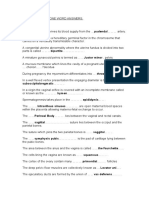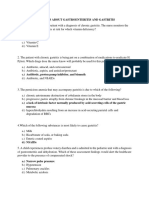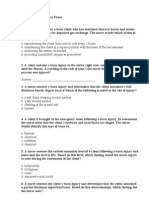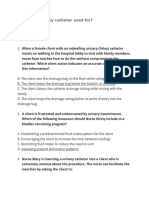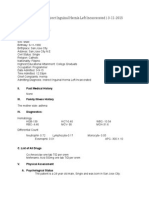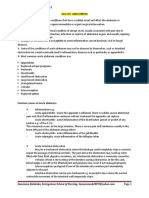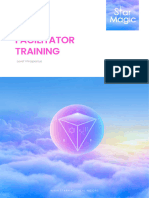Marking Key Amputation
Marking Key Amputation
Uploaded by
Fan EliCopyright:
Available Formats
Marking Key Amputation
Marking Key Amputation
Uploaded by
Fan EliOriginal Title
Copyright
Available Formats
Share this document
Did you find this document useful?
Is this content inappropriate?
Copyright:
Available Formats
Marking Key Amputation
Marking Key Amputation
Uploaded by
Fan EliCopyright:
Available Formats
AMPUTATION
(i) Draw and lable the femur:
N.B Check diagram in Wilson and Ross page 390, Figure 15.38.
(12%.)
(ii) 5 Indications of Amputation:
1. Infection such as gangrene
2. Vascular disease (peripheral)
3. Trauma crushing injuries
4. Burns (electric)
5. Congenital deformities
6. Chronic osteomyelitis
(a)Identify and explain 4 investigations (12%)
1. X-ray of the bone - to confirm diagnosis
2. Serum alkaline phosphate - will be elevated
3. Bone scan - to detect extent of cancer
4. Chest x-ray - to eliminate metastasis
5. Renal and liver function test to check effect on these organs
6. Bone biopsy - to confirm the diagnosis after identifying cancer cells.
DISCUSS THE POST OP CARE THE FIRST 72 HOURS; (50%)
Objectives (2%)
1. To prevent complications e.g. pain, haemorrhage
2. To maintain psychological stability
Breathing:
Ensure patent airway by good positioning
Patient lies flat on the bed with no pillows
Recumbent position with head tilted on one side (Give 3%)
Observations:
*1/4 hourly vital signs obs and general condition
Then 1/2 hourly, e.t.c.
Low blood pressure may denote passive bleeding or severe blood loss in
theatre. Give I.V fluids such as normal saline should the BP be low.
High pulse rate denotes bleeding or severe blood loss
Observe and watch for bleeding from the stump.
Observe for rest of stump by putting a well folded towel in between two
said bags to rest the stump.
Observe for signs of pain and give appropriate measures. Give 7%.
Pain Relief: 5%
Surgical be controlled by narcotics such as pethidine 100 mgs PRN
Evacuation of accumulating fluid and blood by a drain and bag help to
relieve pain.
This is to prevent haematoma formation which causes severe pain
Change of position relieves discomfort and pain arising from bony
prominence pressure.
Placing towel above the stump placed in position by two sand bags on
each side reduces movement of stump which causes discomfort arising
from spasm
Phantom pain on the removed part is prevented by keeping patient occupied.
Minor tranquillisers may be given. Give 5%.
Care of stump - 7%
Elevate the foot of the bed to prevent swelling of the stump as elevation
promotes drainage.
Observe for bleeding from the stump which could be from a loosed suture
by collaborating with vital signs.
Bed cradle be placed on the bed to lift the weight of beddings as this may
spike spasms.
Observe the change of colour of bandage as this may indicate infection.
Don't open the dressing or bandage any how to prevent infection from
setting in.
Prevent infection by administering prophylactic broad spectrum
antibiotics as ordered.
The bandage is left intact in all the 72 hours. Give 7%.
Psychological Care:
Loss of limb causes severe grieving
Be understanding if change of behaviour is seen e.g. crying, withdrawal.
Depression, etc.
As a nurse acknowledge the loss
Create an accepting and supportive atmosphere
Spiritual care by the clergy is very important
Be a good listener.
Allow the patient to ventilate
Explain the change of bed by cradles, sand bags, drains, bed elevation for
co-operation.
Relief of pain will help greatly in reducing anxiety
Explain on the use of crutches.
Support patient in coping process.
Exercise and Ambulation: 4%
Patient will be bed ridden for a long time even in the whole of 72 hours.
Chest exercises to prevent pneumonia.
Passive exercises of other limbs to prevent contractures.
Turnings two hourly to prevent bed sores formation but also to prevent
constipation. Give 4%
Nutrition 3%
Patient begins to eat once he has fully recovered from anaesthesia.
Food rich in proteins and vitamins for healing of stump
Encourage a lot of fluids to encourage defecation and urination since bed
riddeness causes stone formation.
Elimination: 2%
Promote urination by giving plenty oral fluids
Give a laxative to promote opening bowels
Hygiene - 3%
Bed bath for self esteem and blood circulation
Pressure area care to prevent bedsores and two hourly turnings
Encourage patient to do what he can e.g. mouth care.
Health education: 3%
Walking exercises with crutches
Teach how to wrap the residual stump
Advise patient to care for the other limb to prevent injury. Total 50%.
For
sub headings 1% - Objectives - 2%.
(a)Four complications and prevention:
1. Oedema 1%
2. Fat embolism 1%
3. Gas gangrene of stump 1%
4. Deformity of stump 1%
5. Reactionary/secondary haemorrhage. 1%
Prevention:
1. Haemorrhage: 3%
Prevention is by good ligating in theatre, prevention of infection and
resulting the stump.
2. Fat Embolism: 3%
Good suturing in theatre will have to be ensured to prevent this.
3. Gas Gangreme: 3%
This is prevented by ensuring sterility in theatre
Do not open the wound or bandage in the whole of 72 hours.
4. Oedema of stump: 3%
Prevent this by keeping the bandage on the stump tight
If it comes out then re-tie it tight back
Elevation of foot bed.
5. Deformity of stump: 3%
Avoid hip flexion
Good bandaging technique to ensure good alignment and narrowing of the
distal stump for possible fixation of prosthesis. Total = 16%, 1% for listing,
3% for prevention, for 4 total is 16%.=44%
You might also like
- Oral and Maxillofacial Pathology Neville 4edDocument878 pagesOral and Maxillofacial Pathology Neville 4edElsa De Ms100% (5)
- Enthesopathies Knowledge Update - Dreisilker, Ulrich, Dr. MedDocument164 pagesEnthesopathies Knowledge Update - Dreisilker, Ulrich, Dr. MedMarco100% (1)
- Marking Key For GNC November 2019 Mental Health and Psychiatry ExaminationDocument17 pagesMarking Key For GNC November 2019 Mental Health and Psychiatry ExaminationFan Eli100% (14)
- Marking Key For GNC November 2019 Mental Health and Psychiatry ExaminationDocument17 pagesMarking Key For GNC November 2019 Mental Health and Psychiatry ExaminationFan Eli100% (14)
- Exam 1 (NUR-152)Document5 pagesExam 1 (NUR-152)davidvpnNo ratings yet
- Gerd, Peptic Ulcer, Ulcerative Colitis, Crohn's DiseaseDocument11 pagesGerd, Peptic Ulcer, Ulcerative Colitis, Crohn's Diseasekamipima100% (1)
- RENR Review Practice MCQ 2022-2023 QuestionsDocument434 pagesRENR Review Practice MCQ 2022-2023 Questionsracquel johnsonNo ratings yet
- Surgery GNC RN FINAL EXAM QUESITION PAPERDocument149 pagesSurgery GNC RN FINAL EXAM QUESITION PAPERFan Eli100% (7)
- GNC SSN Past Paper 18-1Document32 pagesGNC SSN Past Paper 18-1Fan Eli100% (30)
- Mental Health-With Answer GuideDocument11 pagesMental Health-With Answer GuideFan Eli100% (11)
- Mental Health-With Answer GuideDocument11 pagesMental Health-With Answer GuideFan Eli100% (11)
- Surgery GNC RN FINAL EXAM QUESITION PAPERDocument149 pagesSurgery GNC RN FINAL EXAM QUESITION PAPERFan Eli100% (7)
- GNC SSN Past Paper 18-1Document32 pagesGNC SSN Past Paper 18-1Fan Eli100% (30)
- Dermal Filler Consent FormDocument2 pagesDermal Filler Consent FormYasmeenafsar ShaikNo ratings yet
- Wa0022Document19 pagesWa0022Fan Eli50% (2)
- Irh AnswersDocument7 pagesIrh AnswersFan Eli100% (4)
- General Management of A Patient Undergoing SurgeryDocument30 pagesGeneral Management of A Patient Undergoing SurgeryFan Eli100% (2)
- Paedics Objective RefixDocument70 pagesPaedics Objective RefixSalomey Aggrey100% (4)
- Mental Health & Psychiatric Nursing - Filling QuestionsDocument8 pagesMental Health & Psychiatric Nursing - Filling QuestionsFan Eli90% (10)
- 2011 NMC QuestionsDocument8 pages2011 NMC QuestionsKwabena Amankwa100% (2)
- Nursing Health Assessment Practice QuestionsDocument22 pagesNursing Health Assessment Practice QuestionsSraddha PatelNo ratings yet
- Surgery MCQ-1Document35 pagesSurgery MCQ-1Fan Eli100% (15)
- NCLEX Review QuestionsDocument14 pagesNCLEX Review QuestionsMariel EstoniloNo ratings yet
- Mental Health Nursing Practice Test 1Document14 pagesMental Health Nursing Practice Test 1Dr. Jayesh Patidar100% (26)
- Surgery MCQ-1Document35 pagesSurgery MCQ-1Fan Eli100% (15)
- Multi Choice Questions Surg IrhDocument58 pagesMulti Choice Questions Surg IrhFan Eli100% (14)
- Irh AnswersDocument7 pagesIrh AnswersFan Eli100% (4)
- General Management of A Patient Undergoing SurgeryDocument30 pagesGeneral Management of A Patient Undergoing SurgeryFan Eli100% (2)
- General Management of A Patient Undergoing SurgeryDocument30 pagesGeneral Management of A Patient Undergoing SurgeryFan Eli100% (2)
- GBL Marking KeysDocument15 pagesGBL Marking KeysFan Eli100% (1)
- Surgery November 2019 PDFDocument5 pagesSurgery November 2019 PDFFan Eli100% (2)
- Pre - Operative SurgeryDocument3 pagesPre - Operative SurgeryFan Eli100% (5)
- Psychotic Disorders: Fountain of Peace College of Health SciencesDocument41 pagesPsychotic Disorders: Fountain of Peace College of Health SciencesFan Eli100% (1)
- Prepared by Namayipo Nankamba (RN/RM/BSC NRS) Kefasi Techlar (RN/RM/BSC NRS) Jannes N. Chilumba (RN/RM/BSC NRS/MPH)Document35 pagesPrepared by Namayipo Nankamba (RN/RM/BSC NRS) Kefasi Techlar (RN/RM/BSC NRS) Jannes N. Chilumba (RN/RM/BSC NRS/MPH)Fan Eli50% (2)
- Ent and OptalmologyDocument138 pagesEnt and OptalmologyFan Eli100% (3)
- Get Busy 2 MPDocument35 pagesGet Busy 2 MPFan Eli100% (1)
- One Word Answer Questions Covering DermatologyDocument5 pagesOne Word Answer Questions Covering DermatologyFan Eli50% (2)
- Psychiatric PVDocument9 pagesPsychiatric PVFan Eli100% (2)
- Short Answer Questions - Psych NursingDocument3 pagesShort Answer Questions - Psych NursingFan Eli100% (3)
- Surgery GNC BankDocument58 pagesSurgery GNC BankFan Eli90% (10)
- SURGERY MockDocument15 pagesSURGERY MockFan Eli100% (1)
- GNC Psy Nursing QuestionsDocument34 pagesGNC Psy Nursing QuestionsFan Eli100% (1)
- Questions About Gastroenteritis and GastritisDocument3 pagesQuestions About Gastroenteritis and GastritisGenette Sy SolisNo ratings yet
- FON Qs For PracticeDocument11 pagesFON Qs For PracticeDr Mrinalini BakshiNo ratings yet
- Psychiatric History and Mental State Examination KabweDocument64 pagesPsychiatric History and Mental State Examination KabweFan Eli100% (4)
- Foundation of Nursing - Comprehensive Test Part 1 EasyDocument7 pagesFoundation of Nursing - Comprehensive Test Part 1 EasyJeizel MadayagNo ratings yet
- Nursing Practice QuestionsDocument22 pagesNursing Practice QuestionsMonique Rapley0% (2)
- Paper 2 - NCK Review of Questions (1) BBDocument111 pagesPaper 2 - NCK Review of Questions (1) BBjimwao100% (1)
- FIRST AID QUESTIONS at Original NewchapterDocument8 pagesFIRST AID QUESTIONS at Original NewchapteremmanuelmascotNo ratings yet
- KNUST PsychiatryDocument23 pagesKNUST PsychiatryBraimah Musah IssakaNo ratings yet
- OxygenationDocument7 pagesOxygenationPatziedawn Gonzalvo100% (1)
- Nursing Test Series - 11S: Dr. SANJAY 7014964651Document20 pagesNursing Test Series - 11S: Dr. SANJAY 7014964651Dr-Sanjay SinghaniaNo ratings yet
- ZRN 13 Mental Health MockDocument14 pagesZRN 13 Mental Health MockFan EliNo ratings yet
- ACUTE ABDOMEN-Approach To Managment-HazemDocument57 pagesACUTE ABDOMEN-Approach To Managment-HazemMohamed Hazem ElfollNo ratings yet
- Psychiatric-Mental Health Nursing Sample QuestionsDocument8 pagesPsychiatric-Mental Health Nursing Sample QuestionsBenedict AlvarezNo ratings yet
- 50 Item Integumentary ExamDocument10 pages50 Item Integumentary ExamAijem RyanNo ratings yet
- What Is A Foley Catheter Used ForDocument14 pagesWhat Is A Foley Catheter Used ForSusan MaglaquiNo ratings yet
- Surgery ObjDocument66 pagesSurgery Objmintahmeshackbenjamin50% (2)
- PSYCH NURSING MCQsDocument14 pagesPSYCH NURSING MCQsFan Eli100% (6)
- Psychiatric Emmergency MGT 2 PDFDocument51 pagesPsychiatric Emmergency MGT 2 PDFFan Eli100% (4)
- MCQ's Knust-1Document43 pagesMCQ's Knust-1Khobby JoeNo ratings yet
- Sat Exam-Nrsg ProcessDocument8 pagesSat Exam-Nrsg ProcessRona Lyn100% (2)
- 2023 Hospital Final Paper II TwoDocument44 pages2023 Hospital Final Paper II Twolegendsmasky021No ratings yet
- General Paper September 2020Document26 pagesGeneral Paper September 2020Kumah Wisdom100% (1)
- Refresher 2Document8 pagesRefresher 2Michael Gustilo100% (1)
- Nursing QuestionsDocument23 pagesNursing QuestionsTaSha Kalil MNo ratings yet
- Assessment and PainDocument15 pagesAssessment and PainYa Mei LiNo ratings yet
- Nursing Management in Abdominal SurgeryDocument19 pagesNursing Management in Abdominal Surgeryejguy7777100% (2)
- ATI Med Surg SPRING 2019 Post ReviewDocument11 pagesATI Med Surg SPRING 2019 Post ReviewQuincey Hamilton43% (7)
- Case Study Indirect Inguinal Hernia Left IncauceratedDocument6 pagesCase Study Indirect Inguinal Hernia Left Incauceratedstudent_019No ratings yet
- Ratio - MusculoskeletalDocument28 pagesRatio - MusculoskeletalAccey RamirezNo ratings yet
- Psychiatric History and Mental State Examination KabweDocument64 pagesPsychiatric History and Mental State Examination KabweFan Eli100% (4)
- Psychiatric PVDocument9 pagesPsychiatric PVFan Eli100% (2)
- Surgery GNC BankDocument58 pagesSurgery GNC BankFan Eli90% (10)
- Psychiatric Emmergency MGT 2 PDFDocument51 pagesPsychiatric Emmergency MGT 2 PDFFan Eli100% (4)
- PSYCH NURSING MCQsDocument14 pagesPSYCH NURSING MCQsFan Eli100% (6)
- One Word Answer Questions Covering DermatologyDocument5 pagesOne Word Answer Questions Covering DermatologyFan Eli50% (2)
- Mental Health 2017 NovemberDecember-1Document23 pagesMental Health 2017 NovemberDecember-1Fan Eli100% (2)
- Short Answer Questions - Psych NursingDocument3 pagesShort Answer Questions - Psych NursingFan Eli100% (3)
- SURGERY MockDocument15 pagesSURGERY MockFan Eli100% (1)
- Gaacn Emergency Preoperative Nursing Care RevisedDocument29 pagesGaacn Emergency Preoperative Nursing Care RevisedFan EliNo ratings yet
- GNC Psy Nursing QuestionsDocument34 pagesGNC Psy Nursing QuestionsFan Eli100% (1)
- Get Busy 2 MPDocument35 pagesGet Busy 2 MPFan Eli100% (1)
- Some of The Important Diagrams You Have To Know Before GNC: by Abel Maiya GBL RN StudentDocument23 pagesSome of The Important Diagrams You Have To Know Before GNC: by Abel Maiya GBL RN StudentFan EliNo ratings yet
- PPH Marking Key Boas Bwale RN, RMDocument6 pagesPPH Marking Key Boas Bwale RN, RMFan EliNo ratings yet
- Ent and OptalmologyDocument138 pagesEnt and OptalmologyFan Eli100% (3)
- Surgical ConditionsDocument116 pagesSurgical ConditionsFan EliNo ratings yet
- غيث GTITHDocument199 pagesغيث GTITHElsayed Abdallah100% (2)
- Halab Week 01-03Document70 pagesHalab Week 01-03Kaye bagasinNo ratings yet
- Sampaga, Vince Akira N. Ci: Sir. Buen Anghel Guisala BSN 3A-A Date: 3/10/2024Document2 pagesSampaga, Vince Akira N. Ci: Sir. Buen Anghel Guisala BSN 3A-A Date: 3/10/2024Vince AkiraNo ratings yet
- Gordons Interview Form (MCN)Document5 pagesGordons Interview Form (MCN)teuuuuNo ratings yet
- Application Form: Department of HealthDocument1 pageApplication Form: Department of Healthmswd0% (1)
- DOH COVID19 EO20216EmployeeFaceCovering 041420Document2 pagesDOH COVID19 EO20216EmployeeFaceCovering 041420Liz BenjaminNo ratings yet
- Junior Assistant Syllabus PDFDocument29 pagesJunior Assistant Syllabus PDFAnil SharmaNo ratings yet
- Facilitator-Training Prospectus Level1 2024 v3Document22 pagesFacilitator-Training Prospectus Level1 2024 v3meydaminervaNo ratings yet
- Effect of Iron Containing Supplements On Rats DenDocument6 pagesEffect of Iron Containing Supplements On Rats Dendhea hutabaratNo ratings yet
- Franchesca and Ria Final Thesis Revision (May 3 2022) UPDATEDDocument165 pagesFranchesca and Ria Final Thesis Revision (May 3 2022) UPDATEDBianca CamangianNo ratings yet
- Orange County Firefighters File Lawsuit Over COVID Vaccine MandateDocument27 pagesOrange County Firefighters File Lawsuit Over COVID Vaccine MandateDaniel R. DahmNo ratings yet
- Crash Course Study Guide Master Part 12 1Document92 pagesCrash Course Study Guide Master Part 12 1Lou Escobar100% (1)
- Cleaning & Disinfection GuidelinesDocument36 pagesCleaning & Disinfection GuidelinesGen LuisNo ratings yet
- Causation and Prevention of Diseases: - Dr. Haryax PathakDocument12 pagesCausation and Prevention of Diseases: - Dr. Haryax PathakDr Ashish ManochaNo ratings yet
- Arcoxia - ProspectDocument4 pagesArcoxia - ProspectIoana CorinaNo ratings yet
- Zoll X Series PDFDocument352 pagesZoll X Series PDFThiago GregisNo ratings yet
- Concept MapDocument2 pagesConcept MapAnnie TicualaNo ratings yet
- Lovely Professional University Mittal School of BusinessDocument16 pagesLovely Professional University Mittal School of BusinessAnkit pattnaikNo ratings yet
- Industrial Training ReportDocument35 pagesIndustrial Training ReportAgbama Christopher ErunsunraNo ratings yet
- PellagraDocument13 pagesPellagraSpam SpamNo ratings yet
- ESOPHAGITISDocument5 pagesESOPHAGITISShenna RegaspiNo ratings yet
- Parameters of Quality ControlDocument36 pagesParameters of Quality ControlAngelo Jude CobachaNo ratings yet
- South Korean Haircare Trends 2020Document21 pagesSouth Korean Haircare Trends 2020đạt QuốcNo ratings yet
- January 2021 (IAL) QP - Unit 4 Edexcel Biology A-LevelDocument32 pagesJanuary 2021 (IAL) QP - Unit 4 Edexcel Biology A-LevelMusyoka DanteNo ratings yet
- Cardiovascular & Respiratory System Immunology - PPT (Compatibility Mode)Document64 pagesCardiovascular & Respiratory System Immunology - PPT (Compatibility Mode)Mwanja MosesNo ratings yet
- Trauma in The Aging PopulationDocument21 pagesTrauma in The Aging PopulationBruce Fredy Chino ChambillaNo ratings yet
- Lived ExperiencesDocument9 pagesLived ExperiencesmunjungaNo ratings yet










